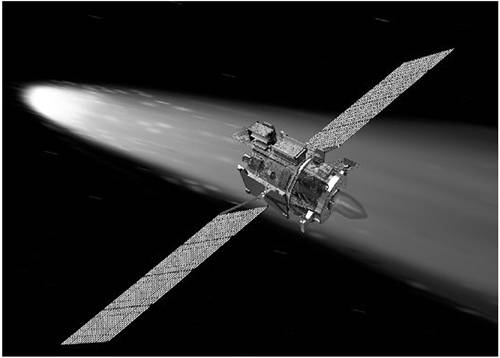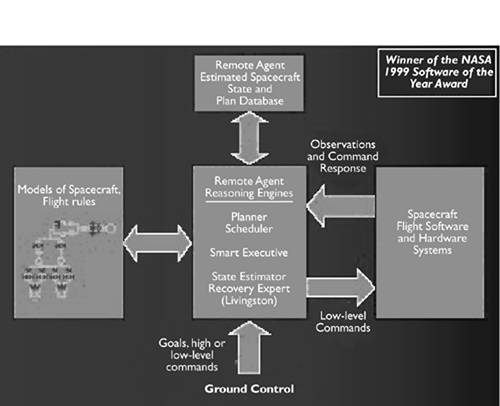| Space is the last great frontier that awaits us. However, due to the size and nature of space and the distances involved, there are some basic fundamental problems that must be solved. The successful exploration of space will require a large number of cheap, agile, and smart spacecraft that can undertake ambitious missions to the far corners of the universe. Spacecraft will be very different from the vehicles that we have developed over the last 30 years. The new age of space exploration will require spacecraft to be independent, autonomous, and smart. They must be capable of self managing and solving problems without human intervention. In the past, vast numbers of staff were needed to carry out all the necessary functions to design, launch, track, manage, and retrieve a spacecraft, and then interpret the data or results. This approach is no longer viable or acceptable due to a number of factors, such as: -
Space is massive and requires travelling huge distances. -
Missions have been very expensive. -
Large-scale automation is necessary for deep space exploration. Automation implies sophisticated software. -
Humans cannot endure multiyear space flights, hence unmanned missions are required. To engage in this approach, organizations such as NASA have been developing numerous autonomic based technologies to address many of these issues. NASA's New Millennium Project (NMP) is one such example. It is the first example of autonomous based software that will, in combination with other Artificial Intelligence software, completely control a space exploration mission. The NMP will accelerate the infusion of technologies into the space and Earth science missions of the 21st century. The program plans a series of technologies—anticipating a rate of two flights per year—which will demonstrate technologies for deep space and Earth-orbiting missions that will work successfully. In tandem with developing and validating new technologies, NMP is also undertaking new management approaches, particularly in the area of partnering between government and industry. A novel application of the concept of integrated product development teams (IPDTs) is being pursued: one in which cross-organizational teams, made up of members from government, industry, and academia, create road maps for development of high pay-off technologies, such as agent technology, that NMP intends to validate through flights. The IPDT approach is expected to reduce costs and improve product. These are examples of the management challenges that must be addressed today to more efficiently undertake space exploration and Earth observation in the 21st century and beyond. How Do the Costs Compare? To give some perspective on how much taxpayer money is being spent to accomplish these extraordinary goals in space exploration—and ultimately to enhance mankind's understanding of the universe we live in—consider this comparison. The budget for the movie Titanic was over $200 million, which was more than the budget for the Deep Space One (DS1) mission from 1998 to 2001 ($139.5 million). DS1 flew by an asteroid and returned information on the kind of celestial body that might once have slammed into Earth million of years ago. DS1 also flew by a comet and took pictures and measurements of its tail, gathering information that might give scientists clues on the origins of the solar system—all for less than the cost of a single Hollywood movie. NASA created the most advanced spacecraft artificial intelligence software yet developed for launch aboard DS1. The Deep Space One Mission The robotic Deep Space One (DS1) spacecraft carried no crew and with a total mass of 945 pounds, was much smaller than conventional craft—see Figure 3.3—but its autonomic computer intelligence program, known as the Remote Agent, shared the same basic goal of operating and controlling a spacecraft with minimal human assistance. Figure 3.3. The Deep Space One craft looks familiar to normal spacecraft—but it is completely self sufficient, self-managing, and autonomous. 
The autonomic computer software on board DS1 represents a big step forward in spacecraft autonomy. It is designed to allow spacecraft to make a wider variety of decisions for themselves than they were able to in the past. DS1's Remote Agent software is capable of planning and executing many activities onboard the spacecraft, with only general direction being given from ground controllers on Earth. In contrast to remote control, this software acts as an autonomous "remote agent" of controllers because they rely on it to achieve particular mission goals. Ground controllers do not tell the agent exactly what to do at each instant of time, as they do with conventional spacecraft. The software logically reasons about the state of the spacecraft, and the Remote Agent considers all of the consequences of its actions. The Remote Agent was developed in a collaborative effort between NASA, Ames, and the Jet Propulsion Laboratory (JPL), Pasadena, CA. Autonomous Models The Remote Agent should enable future spacecraft software to be more easily designed. The first version of Remote Agent was the most difficult to create and test. Now, NASA should be able to copy it for the next mission, making improvements rather than redeveloping the software from scratch. It will be continuously improved with knowledge gained from each mission. This is made possible by model-driven software. Models of the spacecraft's components and environment are given to the Remote Agent, which figures out the necessary detailed operating procedures on its own. Only the models need to be updated for each new spacecraft. Given NASA's continuing efforts to develop many smaller, less expensive science spacecraft, there is a need to perform each mission with less than a dozen ground controllers instead of the hundreds of people previously needed to run a major planetary science mission. The large distances inherent in planetary exploration result in communications that can be painfully slow during normal operations and totally unacceptable during emergencies. Even signals from the nearby planet Mars take 11 minutes to be received. And sometimes your communication pathway is blocked when a planet is between the spacecraft and Earth. Three parts of Remote Agent work together to demonstrate that it can autonomously operate a spacecraft: High Level Planning and Scheduling, Model-based Fault Protection Explorer, and Smart Executive. See Figure 3.4. Figure 3.4. The autonomic architecture diagram of the DS Remote Agent technology. 
Some estimates show a 60 percent reduction in mission costs using the Remote Agent. The software would replace a large section of the human spacecraft control team back on Earth. The High Level Planning and Scheduling part of Remote Agent will constantly look ahead to the schedule for several weeks of mission activities. The Planner is mostly concerned with scheduling spacecraft activities and distributing resources such as electrical power. The Planner allows a small spacecraft control team on Earth to command the spacecraft more effectively by sending goals instead of detailed instructions to DS1. The fault protection portion of the Remote Agent, known as "Livingstone" (named after the missionary and African explorer of the 19th century), functions as the mission's virtual chief engineer. If something should go wrong with the spacecraft, Livingstone would use the computer model of how the spacecraft should be behaving to diagnose failures and suggest recoveries. The third part of the Remote Agent software, Smart Executive, acts as the "executive officer" of the mission, issuing general commands to fly DS1. The Executive has to be able to execute the plans that are produced by the Planner and Livingstone. If the Planner had to worry about every single detail, it would be hard pressed to produce a plan. So, the Executive takes care of the details. The Executive also can receive a plan or single commands directly from ground controllers. However, if the ground plan won't work, the Executive can say, "Sorry, Ground, I can't do that." This can actually be a big help to ground controllers, who currently expend enormous effort double-checking every command and still don't always get it right. In a sense, they can test different scenarios in real time. In the event that the Remote Agent won't cooperate under some unusual circumstance, NASA is developing a surgery mode, where ground control can really get into Remote Agent and take corrective action. Remote Agent may someday lead to software that would be incorporated into a space robot that would be as intelligent as HAL 9000 in the movie 2001:A Space Odyssey. The New Millennium Program has accelerated technology development in autonomous based spacecraft automation by at least ten years. The Remote Agent will open up new exploration opportunities, allowing us to really begin the in situ era of space science. Future systems also should be able to learn about their environment and act in partnership with scientists to find and analyze new discoveries. The key issue for the program in the next few years will be to continue to make it work successfully. Looking ahead even further, NASA plans to build a fleet of these smart spacecraft, called constellations or armadas, and let them explore different places, share their findings, and even divide amongst themselves the work of achieving complex scientific goals. Systems like the Remote Agent will be crucial to supporting components of this vision. Implications for Future Missions If DS1 shows that electric propulsion works as well as expected, there will be many new missions that will take advantage of it. Ion propulsion is not of value for missions that require high acceleration, and it often will not be worthwhile for missions that can be done quickly using conventional propulsion systems (such as missions to the moon). But for a wide variety of missions with high energy requirements (such as missions to asteroids and comets, Mercury and the inner solar system, and some to the outer solar system), the low but steady acceleration of ion propulsion wins out over the less efficient bursts from chemical alternatives. The real benefit of spacecraft autonomy is to enable a new kind of space exploration where the spacecraft will face much higher degrees of uncertainty. Such missions include exploring the oceans of Europa and the terrain and atmosphere of Venus. The Remote Agent software will also allow a faster response by the spacecraft to in-flight situations when ground controller intervention is not possible due to communication delay. For instance, autonomy capability is needed to maneuver a spacecraft in a hazardous environment, such as landing on an active comet where there are dangerous flying rocks. Furthermore, mission development and operations costs will also be reduced. The magnitude of the benefits is difficult to quantify however and cannot be fully realized through flying the Remote Agent on one or two experimental flights. The full benefits of this software can only be realized over time and by maturing the technology through use on many future missions. After DS1, NASA intends to work on even more autonomous spacecraft that could reconfigure themselves. If some part of such a spacecraft performed differently during the mission than expected, the craft would be able to detect this and change software models and algorithms to self-adapt. Deep Space 1 exceeded all its goals in successfully testing autonomic technology for self-managing space missions. For more information visit The New Millennium Project at http://nmp.jpl.nasa.gov/. | 
